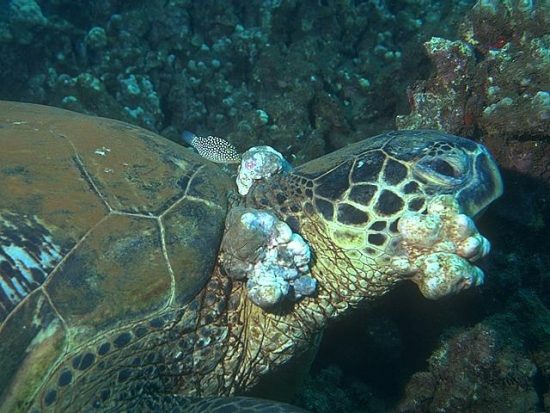





Disease causes growths that obstruct turtle's vision
Green sea turtles, which are currently endangered, are facing another
threat – a debilitating disease that is suspected to be due to
human-induced pollution.
In the past three years, Karina Jones from James Cook University in
Townsville, Australia has investigated fibropapillomatosis (FP) among
green sea turtles in the Great Barrier Reef. FP is a turtle-specific
herpes virus that remains dormant in almost 90 percent of all afflicted
turtles.
Although the tumours are benign, they cause abnormal growths (as large
as 30 centimetres across) on the turtles' eyes, mouth, flippers, tail,
skin and internal organs; this can obstruct their vision, preventing
them from finding food or detecting predators or boats.
Jones has identified an area near Cockle Bay at Magnetic Island (a
popular tourist destination) as one of the hotspots of the disease.
Here, roughly half of the turtles have been afflicted with the disease,
compared to around 10 percent in the other areas of Cockle Bay.
The precise cause of the outbreak is yet to be determined, but
environmental pollutants are high on the list of suspects. "We see
these tumours in turtles in very localised hotspots around the world
where there is heavy human activity." In healthy marine environments,
many turtles do carry the virus, but it often remains dormant without
any symptoms. This has led Jones to speculate that "there must be some
external trigger that causes the tumour development."
The FP outbreak is not limited to the Great Barrier Reef, as there is
also an increase of cases reported in Florida and Hawaii, particularly
near onshore farming areas. Doug Mader, from the Turtle Hospital in
Marathon, Florida, also suspects that pollution is to blame. His
facility has seen an increase in the number of afflicted turtles over
the last 20 years.
For Jones, the next step is to find out which contaminants are
responsible for the outbreak. To this end, she and her team are looking
into the historical water quality data, and comparing it with the
present-day data. They will also carry out extensive tests on water
samples to identify the heavy metals, fertilisers and pesticides
present in the water.
As well-intentioned as their efforts may be, time continues to run out
for the green sea turtle, though. The green sea turtle is listed as
"Endangered" on the IUCN Red List of Threatened Species, with about
200,000 left worldwide.
As the second largest sea turtle in the world, the green sea turtle can
grow up to 1.5 metres long and weigh up to 200 kilogram’s. They live
primarily in warm, tropical seas. They lay their eggs on beaches and
bays in Australia, Florida, Hawaii, Costa Rica and Japan. Besides the
current FP outbreak, they also face several threats, including the
excessive harvesting of their eggs, hunting, ending up as by-catch in
fishing nets, and the loss of their nesting grounds as beaches get
developed for tourism.
See also: Article in NewScientist
 Herbert
Herbert 11th July 2016
11th July 2016